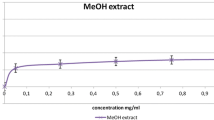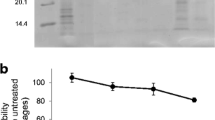Summary
The present study was designed to examine whether the antitumor cells induced by treatment with mitomycin-C-treated EL4 cells (EL4MMC) plus OK-432 plus cyclophosphamide differed from those induced by treatment with EL4MMC plus OK-432 in terms of their cell types and antitumor mechanisms. Antitumor activity of peritoneal exudate cells (PEC) from mice receiving either treatment was nonspecific, and inhibition of their target cell growth increased for up to 24 h. Macrophage toxin, silica and trypan blue abrogated the activity in vitro and in vivo, respectively. The activity of the PEC was inhibited with inhibitors of the arachidonic acid cascade, such as dexamethasone, 4-bromophenacyl bromide and nordihydroguaiaretic acid but not esculetin, ibuprofen, indomethacin and BW755C.N G-monomethyl-l-arginine, a specific competitive inhibitor of thel-arginine-dependent nitric oxide synthesis, also inhibited the activity. These results and morphological observations indicated that antitumor cells in the PEC from mice receiving either treatment were macrophages, and that their activity was closely related to the arachidonic acid cascade and to nitric oxide. Antitumor activity of the PEC spontaneously decayed in vitro and this decay was inhibited by the addition of OK-432 or lipopolysaccharide. On the other hand, cyclophosphamide sustained the appearance of antitumor cells in mice treated with EL4MMC plus OK-432. Therefore, cyclophosphamide treatment did not modify cell types and cytotoxic mechanisms of antitumor cells elicited with EL4MMC plus OK-432, but did modify the induction kinetics of such antitumor macrophages.
Similar content being viewed by others
References
Balsari A, Marolda R, Gambacorti-Passerini C, Sciorelli G, Tona G, Cosulich E, Taramelli D, Fossati G, Parmiani G, Cascinelli N (1986) Systemic administration of autologous, alloactivated helper-enriched lymphocytes to patients with metastatic melanoma of the lung. A phase I study. Cancer Immunol Immunother 21: 148
Braun DP, Harris JE (1981) Effects of combination chemotherapy on immunoregulatory cells in peripheral blood of solid tumor cancer patients: correlation with rebound overshoot immune function recovery. Clin Immunol Immunopathol 20: 193
Dullens HFJ, Schakenraad S, Oostdijk A, Vuist W, Van Der Mass M, Den Otter W (1986) Specific tumoricidal activity of cytotoxic macrophages and cytotoxic lymphocytes, 22: 100
Eggers AE, Tarmin L, Gamboa ET (1985) In vitro immunization against autologous glioblastoma-associated antigens. Cancer Immunol Immunother 19: 43
Hamburger AW, Dunn FE, Tencer KL (1983) Separation on Percoll density gradients of cells derived from malignant ascites of mice. JNCI 70: 157
Hayashi T, Arai S, Sendo F (1988) The mechanisms of cytotoxicity to tumor cells by polymorphonuclear leukocytes stimulated with cytokines. Jpn J Cancer Res 79: 375
Hibbs JB Jr, Taintor RR, Vavrin Z (1987) Macrophage cytotoxicity: role forl-arginine deiminase and imino nitrogen oxidation to nitrite. Science 235: 473
Hibbs JB Jr, Vavrin Z, Taintor RR (1987)l-Arginine is required for expression of the activated macrophage effector mechanism causing selective metabolic inhibition in target cells. J Immunol 138: 550
Hogan MM, Vogel SN (1988) Inhibition of macrophage tumoricidal activity by glucocorticoids. J Immunol 140: 513
Jones B, Penfold P (1979) Allograft cytotoxicity: critical role for adherent T cells in effector mechanism of the peritoneal population. Cell Immunol 46: 259
Keller R, Geiges M, Keist R (1990)l-Arginine-dependent reactive nitrogen intermediates as mediators of tumor cell killing by activated macrophages. Cancer Res 50: 1421
Lichtenstein AK, Kahle J, Berek J, Zighelboim J (1984) Successful immunotherapy with intraperitonealCorynebacterium parvam in a murine ovarian cancer model is associated with the recruitment of tumor-lytic neutrophils into the peritoneal cavity. J Immunol 133: 519
Mantovani A (1982) The interaction of cancer chemotherapy agents with mononuclear phagocytes. Adv Pharmacol Chemother 19: 35
Melioli G, Baldini E, Mingari MC, De Maria A, Sertoli MR, Badellino F, Percivale PL, Catturich A, Bertoglio S, Civalleri D, Santi L, Moretle L (1989) Phenotypic and functional characteristics of tumor-associated lymphocytes in patients with malignant ascites receiving intraperitoneal infusions of recombinant interleukin-2 (rIL-2). Int J Cancer 43: 231
Moncada S, Palmer RMJ, Higgs A (1989) Biosynthesis of nitric oxide froml-arginine. A pathway for the regulation of cell function and communication. Biochem Pharmacol 38: 1709
Morikawa K, Takeda R, Yamazaki M, Mizuno D (1985) Induction of tumoricidal activity of polymorphonuclear leukocytes by a linear β-1,3-d-glucan and other immunomodulators in murine cells. Cancer Res 45: 1496
Nathan CF, Asofsky R, Terry WD (1977) Characterization of the nonphagocytic adherent cell from the peritoneal cavity of normal and BCG-treated mice. J Immunol 118: 1612
Parmiani G, Anichini A, Fossati G (1990) Cellular immune response against autologous human malignant melanoma: are in vitro studies providing a framework for a more effective immunotherapy?. J Natl Cancer Inst 82: 361
Perret TG, Lemaire G (1986) Dexamethasone inhibits antitumor potential of activated macrophages by a receptor mediated action. Biochem Biophys Res Commun 136: 130
Pickaver AH, Ratcliffe NA, Williams AE, Smith H (1972) Cytotoxic effects of peritoneal neutrophils on a syngeneic rat tumor. Nature 235: 186
Ryoyama K, Ryoyama C (1989) Augmented induction of antitumor cells in vivo by cyclophosphamide fails to benefit antitumor resistance of the host. Cancer Immunol Immunother 29: 255
Ryoyama K, Murayama T, Koshimura S (1979) Effect of OK-432 on immunization with mitomycin-C-treated L1210 cells. Gann 70: 75
Schultz RM, Nanda SKW, Altom MG (1985) Effects of various inhibitors of arachidonic acid oxygeneation on macrophage superoxide release and tumoricidal activity. J Immunol 135: 2040
Stewart CC, Stevenson AP, Hibbs J (1988) Effector mechanisms for macrophage-induced cytostasis and cytolysis of tumor cells. In: Heppner GH, Fulton AM (eds) Macrophages and cancer. CRC press, Florida, pp 39–59
Stuehr DJ, Nathan CF (1989) Nitric oxide. A macrophage product responsible for cytostasis and respiratory inhibition in tumor target cells. J Exp Med 169: 1543
Tappel AL, Lundberg WO, Boyer PD (1953) Effect of temperature and antioxidants upon the lipoxidase-catalyzed oxidation of sodium linoleate. Arch Biochem Biophys 42: 293
Tsuru S, Aiso S, Taniguchi M, Zinnaka Y, Nomoto K (1985) Mechanisms of in vivo generation of cytotoxic activity against syngeneic tumors. I. Local differentiation of mature cytotoxic T lymphocytes in the rejection of tumors. Immunology 54: 281
Tzeng J-J, Barth RF, Orosz CG, James SM (1991) Phenotype and functional activity of tumor-infiltrating lymphocytes isolated from immunogenic and nonimmunogenic rat brain tumors. Cancer Res 51: 23 273
Uchida A, Kariya Y, Okamoto N, Sugia K, Fujimoto T, Yagita M (1990) Prediction of postoperative clinical course by autologous tumor-killing activity in lung cancer patients. J Natl Cancer Inst 82: 1697
Ujiie T (1987) OK-432-mediated augmentation of antitumor immunity and generation of cytotoxic T lymphocytes. Jpn J Exp Med 57: 103
Ujiie T (1987) Chemoimmunotherapy of L1210 leukemia with adriamycin, cyclophosphamide and OK-432, and their effects on the generation of antitumor immunity. Jpn J Cancer Res (Gann) 78: 737
Vanky F, Klein E, Willems J, Böök K, Ivert T, Péterffy A, Nilsonne U, Kreicberg A, Aparisi T (1986) Lysis of autologous tumor cells by blood lymphocytes tested at the time of surgery. Cancer Immunol Immunother 21: 69
Watanabe S, Sendo F, Kimura S, Arai S (1984) Activation of cytotoxic polymorphonuclear leukocytes by in vivo administration of a streptococcal preparation, OK-432. JNCI 72: 1365
Yasumoto K, Miyazaki K, Nagashima A, Ishida T, Kuda T, Yano T, Sugimachi K, Nomoto K (1987) Induction of lymphokine-activated killer cells by intrapleural instillations of recombinant interleukin-2 in patients with malignant pleurisy due to lung cancer. Cancer Res 47: 2184
Zöller M (1985) Evaluation of in vivo and in vitro effectivity of immune defense against a spontaneously arising, nonlymphoid rat tumor. Cancer Immunol Immunother 19: 189
Author information
Authors and Affiliations
Rights and permissions
About this article
Cite this article
Ryoyama, K., Ryoyama, C. Cyclophosphamide modifies the induction kinetics but not cell types and cytotoxic mechanisms of antitumor cells elicited with OK-432 plus attenuated tumor cells. Cancer Immunol Immunother 34, 143–149 (1991). https://doi.org/10.1007/BF01742304
Received:
Accepted:
Issue Date:
DOI: https://doi.org/10.1007/BF01742304




